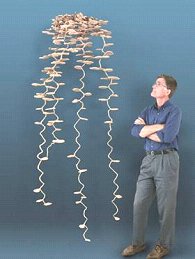Diversity of ground-dwelling ants in primary and secondary forests in Amazonian Ecuador
Kari T. Ryder Wilkie, Amy L. Mertl & James F.A. Traniello
Abstract: An inventory of the ground-dwelling ant faunas of primary and secondary forests at the Tiputini Biodiversity Station in Amazonian Ecuador revealed a total of 101 ant species in 32 genera. Eighty species were collected from the primary forest, while 65 species were collected from the secondary forest. Species overlap between the two sites was low (42.6%) and the composition was significantly different (p<0.0001). Actual species richness was estimated to be 126 species for primary forest and 110 for secondary forest. The most species-rich genus in both habitats was Pheidole (21 species), which was also the most widespread genus, occurring in 38 of 40 collection sites. In the primary forest, in addition to Pheidole (18 species), the most species-rich genera were Crematogaster (8 species), and Pachycondyla (7 species), whereas Pheidole (17 species), Camponotus (5 species), and Pachycondyla (5 species) were the most species-rich genera in the secondary forest. These results are consistent with past studies showing that the number of ant species in secondary forest increases with time from disturbance and may approach that of primary forest within several decades, but that species composition may take significantly longer to resemble that of the original ant assemblage. The prevalence of different ant functional groups in the two habitats is discussed and the results compared to similar studies in Australia and North America.
Ryder Wilkie KT, Mertl AL, Traniello JFA. 2009. Diversity of ground-dwelling ants (Hymenoptera: Formicidae) in primary and secondary forests in Amazonian Ecuador. Myrmecological News 12: 139-147 published Online Earlier 20 April 2009
UPDATE:
printable version


















